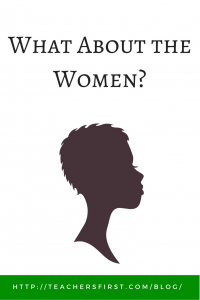 I recently read an article with this question as it pertains to women’s roles in our National Park Service, and I began thinking about how this issue would be an excellent theme for many classrooms. Instead of just focusing on women’s history in March, what would happen if we raised this question throughout the year in all subjects? In fact, what if this were the theme for your classroom from the very beginning?
I recently read an article with this question as it pertains to women’s roles in our National Park Service, and I began thinking about how this issue would be an excellent theme for many classrooms. Instead of just focusing on women’s history in March, what would happen if we raised this question throughout the year in all subjects? In fact, what if this were the theme for your classroom from the very beginning?
Although the school year is well underway, there is plenty of time to make this happen. Older students will begin a new semester soon; that is an obvious starting point for many of you. It isn’t too late for others; now is the time to consider bringing the women’s perspective into future lessons.
How does this work? Instead of featuring women’s history as a once-a-year event, bring women into the conversation as an integral piece of all content. Doing this provides many untapped learning opportunities for students, and taps into your creativity and ability to think outside the box.
Let’s consider some ideas by content area, beginning with the easiest – Social Studies. This subject is the natural starting point for including women in lessons.
- This January we inaugurate a new president. Although the United States has never had a female president, there have been many influential women in politics. Share and research stories of First Ladies and women politicians with your students and the role they played in the story of our country.
- February is Black History Month, take the time this month to include women in Black History lessons. Think beyond the very familiar and easy to find women such as Rosa Parks and Harriet Tubman. Challenge students to find stories within their family or community of influential black women. Have students learn about black women pioneers in different careers.
- March is Women’s History Month, a natural part of your What About the Women? theme. Go beyond famous women in history and encourage students to find female role models in their home and community. Including women on a personal level will leave a lasting impression that being famous isn’t the only way to become a strong woman.
- Use any event in history to look at information from the women’s perspective. What were women doing during that period? What was their role? Were there strong women who played a part?
Science teachers also have ongoing opportunities for including women in lessons throughout the year.
- During your lessons on weather, ask a female weather broadcaster in your area to present to your class. In fact, make it a point to bring in female speakers as much as possible.
- Make it a point to have students research both scientists of both genders.
- Be sure to include websites specifically created for girls’ inclusion in science and STEM careers when sharing resources with students. One excellent resource is For Girls in Science.
Include women in reading and writing lessons as an integral component of every unit.
- Feature literature that was written or illustrated by women. If your curriculum doesn’t feature many women authors, bring them in through supplemental reading or feature quotes from women throughout your unit.
- Include women poets as part of a poetry unit including modern poets.
TeachersFirst offers a Special Topics page featuring Women’s History Month Resources. This page provides many resources for teaching about women in history throughout the year in all subject areas. It is worth spending some time there to browse around for new ideas and resources for students of all ages.
One natural, important outcome of including women throughout the year is that students become aware of women’s achievements as a standard part of learning, not as something pointed out once a year and then put back in the closet. Now might be the time to take action to include women and their role in history at every opportunity. Consider the question, What About the Women? with each and every lesson and think of ways to include women as part of the content.
What do you think? Have you already featured women throughout the year in your classroom? Share your favorite ideas in the comments below.


One thought on “What About the Women?”